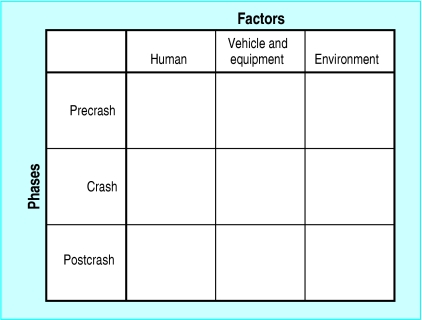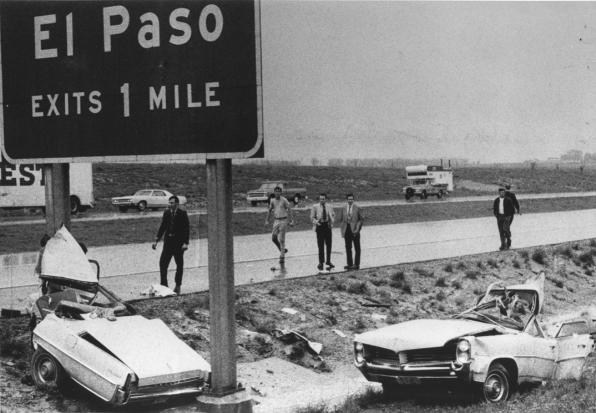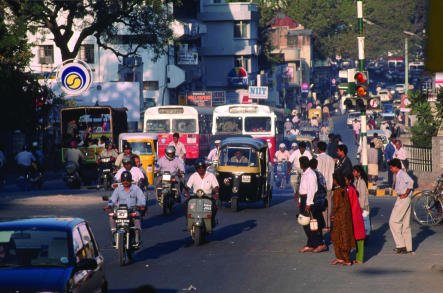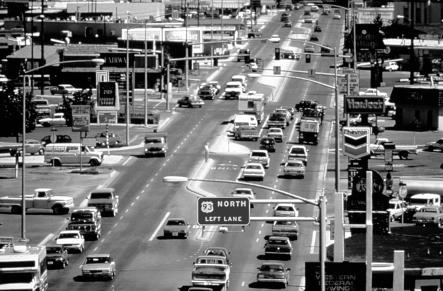The United States was the first country to experience deaths and injuries from motor vehicle crashes in large numbers. As other countries motorised, they, too, experienced large numbers of crash deaths and injuries. Early efforts to address this problem were based largely on guesswork, with the principal focus on educating motorists. This simplistic and narrow approach continued for decades, even though the numbers of crash deaths and injuries continued to grow.1
In the 1960s a public health approach to the problem emerged in the United States and other motorised countries. Under this new approach, the available prevention options greatly expanded, and the effectiveness of countermeasures was scientifically evaluated before widespread adoption. This emphasis on evaluation was important because the earlier efforts continued for decades without evaluation, and when some of these programmes were eventually evaluated there was no evidence of effectiveness.2
Today motor vehicle crashes are causing substantial numbers of deaths in countries that are relatively new to motorisation.3 A key question is how these countries can avoid the many unnecessary deaths and serious injuries that occurred in today's motorised countries during the decades that motor vehicle use was rapidly expanding, ineffective countermeasures were in place, and potentially effective countermeasures were being ignored.
Summary points
One consequence of the rapid growth in motor vehicle use in many countries is increasing numbers of crash deaths and injuries
To reduce this toll, countries need to adopt a broad array of research based measures
Despite being widely advocated as essential safety programmes, driver education or training programmes have not been found to reduce motor vehicle crashes
Almost all of the demonstrable gains produced by changing road user behaviour have resulted from properly enforced traffic safety laws
In many less motorised countries a disparate mix of road users share the roads, and so local measures will be required, such as setting safety standards for the front ends of motor vehicles to make them less hazardous for pedestrians and bicyclists
Methods and review of the evidence
This review reflects the authors' knowledge accumulated over more than 50 years combined in this subject. The published literature on highway safety is unfortunately fragmented and not always easy to retrieve. For example, many articles on various aspects of the crash performance of vehicles and human tolerance to injury are published in various specialist journals that focus on biomechanics and other aspects of vehicle crashworthiness. But the published research on behavioural issues tends to be widely scattered, with work relating to traffic laws and enforcement appearing in publications ranging from public health journals to criminology journals.
Medical journals have frequently rejected research on behavioural issues, especially those showing various road safety programmes to be ineffective. This publication bias is well known in scientific literature but is especially unfortunate in the case of safety programmes aimed at changing road user behaviour because the overwhelming bulk of programmes, when scientifically evaluated, have not been shown to be effective. This means that often only researchers who have been active in the subject for many years are aware of the many unpublished (or published in sources other than scientific journals) articles on ineffective programmes. Yet the field of road safety is constantly faced with enthusiastic newcomers who are convinced that their particular countermeasure will be effective. As a result, resources are continually squandered on ineffective programmes.
Research based countermeasures
The public health approach to road safety has resulted in a mix of countermeasures, and the choices among them are driven by research on their effectiveness. This mix includes measures aimed at improving vehicles, roads, and road user behaviour. A planning tool used to help identify the complete range of options is the Haddon matrix,4 derived by first dividing the time sequence of a crash into three phases (precrash, crash, and postcrash) and then considering the human, vehicular, and environmental factors that can interact during each phase of a crash. The result is a nine cell matrix, each cell of which offers opportunities for intervention to reduce motor vehicle crash injuries (fig 1).
Figure 1.
The Haddon matrix, used to help identify possible countermeasures to road vehicle crashes
Under the old approach virtually all prevention efforts were focused in the precrash-human cell. Opportunities to prevent deaths and injuries by taking measures such as designing better vehicles or less hazardous roadsides or improving emergency medical systems were ignored.5 The failure to identify a range of countermeasures meant, for example, that as late as the 1970s newly built highways in the United States had rigid signposts and other roadside hazards that guaranteed that the consequences of many crashes would be severe (fig 2).
Figure 2.
As late as the 1970s newly built highways in the United States had rigid signposts and other roadside hazards, which meant that the consequences of a vehicle hitting one would be severe
Changing road user behaviour
In motorised countries today most countermeasures have been shown by good research to be effective. Vestiges of the older unscientific approach still exist, however, and, for measures aimed at road user behaviour in particular, people continue to advocate programmes that have not been shown to be effective.6
Virtually all educational and training programmes aimed at adults that have been evaluated show no evidence of effectiveness. Driver education or training programmes have not been found to reduce motor vehicle crashes, but they still are widely advocated as essential safety programmes.7–9 Research shows driver education programmes can increase knowledge, but this rarely results in appropriate behaviour change. Similarly, driver training programmes have not been shown to reduce crashes. They may be useful for teaching beginning drivers, and in some cases they may improve driving skills, but better skills do not automatically lead to fewer crashes.10 Some advanced driver training programmes have even been shown to make things worse. For example, programmes that taught skid control, off-road recovery, and other emergency measures produced drivers with higher crash rates than drivers who did not take the course.8 Comprehensive reviews of driver and motorcycle training programmes have found no studies showing any crash reductions due to the training.11 Yet blind faith in the education and training of road users continues in many quarters.
The belief that increasing motorists' or other road users' knowledge or skills will produce fewer crashes reflects a naïve view of human behaviour. Most motorists and other road users acknowledge that serious risk taking and other behaviour problems are prevalent among drivers, but few people will admit that they may be part of this problem. Surveys of drivers' self ratings of their skills show that virtually no motorists believe their own skills are below average. So motorists agree that there are many “bad” drivers, but virtually all believe that the “bad” drivers are someone else. For example, drivers in motorised countries know that ignoring stop signs and running red lights are inappropriate behaviours, yet these obviously unsafe actions are common in the United States and are leading causes of crashes.12 Similarly, all motorists know that driving after consuming alcohol increases the risk of crashing, but billions of trips are taken each year by alcohol impaired drivers worldwide.
Traffic laws and enforcement
Almost all of the demonstrable gains produced by changing road user behaviour in motorised countries have resulted from traffic safety laws.13 However, laws by themselves often are not sufficient: the key factor in the effectiveness of a traffic law is motorists' perception that they run a high risk of being detected and punished for violating the law. The perception of likelihood of apprehension is a much stronger deterrent than the severity or the swiftness of the penalty.14 Thus, laws requiring motorcyclists to wear helmets typically produce compliance close to 100% in the United States and much of Europe, largely because riders know they are easy to detect if they ride without a helmet. But in countries where motorcyclists' perceptions are that such laws are not likely to be enforced, levels of helmet use are much lower. Experience in less motorised countries like India confirms this behaviour.15
Laws work because it is possible to convince motorists that they face a considerable risk of punishment if they violate the laws. One reason education fails is that most motorists cannot be convinced that they are at risk of a crash, and many other road users (such as small children, teenagers, and people who are psychologically disturbed, under stress, under the influence of alcohol, or elderly) may not act according to their knowledge. Instead motorists believe it is other, “bad” drivers who are involved in crashes. For laws to work, however, effective enforcement and sanctions must be in place. This is not the case in many countries, so there is a strong tendency to revert to education as the preferred approach to changing road user behaviour.
International issues
In several countries that have been motorised for a long time, motor vehicle crash deaths are no longer increasing. This is largely because of the adoption of countermeasures shown to be effective. However, crash deaths and injuries are increasing dramatically in many countries where motor vehicle use on a large scale is relatively new.3
Some of the countermeasures that are effective in motorised countries will be applicable in others, but some will need to be adapted to local traffic conditions. For example, in many less motorised countries traffic use patterns, especially the disparate mix of road users sharing the same roads, will require traffic engineering measures that are different from those that have been successful in motorised countries, where traffic mixes are more homogeneous (fig 3).5,6,11 Motorcycles dominate the roads in many less motorised countries, and they share the road with bicycles and other human powered vehicles, pedestrians carrying loads, and locally designed vehicles. Today's motorised countries did not experience these kinds of traffic mixes even when they were rapidly motorising, so traffic engineering solutions that work for their traffic are likely to have a much smaller effect on the roads of today's less motorised countries.
Figure 3.
In many less motorised countries a disparate mix of road users share the same roads (top), so traffic engineering measures will be required that are different from those that have been successful in motorised countries, where traffic mixes are more homogeneous (bottom)
Most of the road crash deaths in less motorised countries occur among so called vulnerable road users—pedestrians, bicyclists, motorcyclists, etc. These categories of road users make up a much smaller proportion of crash deaths in motorised countries. This is not necessarily because of successful programmes aimed at such road users. For example, recent estimates from Britain suggest that the number of trips per person made on foot fell by 20% between 1985-6 and 1997-9.16 Such trends suggest that reductions in pedestrian fatalities could be largely because of the reduced exposure of these road users rather than the road environment being “safer” for them. Similarly, pedestrian deaths have been declining for many years in the United States without major programmes to improve their safety. The most likely reason is a decline in walking. In less motorised countries many more pedestrians are killed by impacts with buses and trucks than in motorised countries, so a strong case can be made for pedestrian-friendly fronts for buses and trucks.17 Yet such measures presently are not given any priority.
Motorised countries have safety standards for passenger vehicles, but vehicles exported to less motorised countries often do not meet these standards. It would make sense for all vehicles sold in less motorised countries to conform to some minimum international standards; there should not be a two tier system with safer vehicles sold in motorised countries and less safe ones sold elsewhere. Many less motorised countries manufacture vehicles locally (three wheeled scooter taxis, tuk-tuks, jeepneys, etc) that are not used in motorised countries. These vehicles generally are used as taxis but are not designed with any concern for crash performance. Since they are not used in motorised countries there is little pressure to improve their designs.
Future directions
The above discussion shows why the simple replication of motorised countries' policies in less motorised countries will not be sufficient to address their road safety problems. However, the body of research knowledge can be used as a foundation to develop effective programmes to reduce crash deaths and injuries in less motorised countries. This means using professionally trained practitioners to develop a broad array of appropriate measures. To accomplish this, countries in the process of motorising and experiencing substantial mortality and morbidity from motor vehicle crashes should:
Establish national or regional road safety agencies which should be staffed with trained professionals and be responsible for accident data surveillance and analysis, funding of research activities, setting vehicle and road standards, and developing appropriate traffic engineering approaches18
Promote effective speed control measures, including traffic calming suited for conditions specific to less motorised countries19,20
Develop safety standards for the front ends of motor vehicles to make them less hazardous for pedestrians and bicyclists
Promote safety measures likely to work in all locations—such as daytime running lights for motorcycles, more conspicuous bicycles and other small vehicles, compulsory helmet use for motorcyclists, effective enforcement of laws against alcohol impaired driving21–25
Develop appropriate human resources. Fewer than a dozen road safety professionals presently work in less motorised countries. Training programmes should be institutionalised. This will happen only if road safety and transportation research departments are set up in selected universities and research institutions.
These recommendations reflect policies that have been shown to contribute to highway safety. Newly motorising countries cannot afford to ignore the evidence on what works, and equally important what doesn't work, to reduce deaths and injuries from motor vehicle crashes. In the United States and elsewhere, many lives were lost unnecessarily in crashes during the first 50 years of motorisation because highway safety advocates promoted ineffective measures while at the same time resisting approaches that later were shown to be effective. It will be a tragedy if the countries relatively new to motorisation repeat these mistakes.
Footnotes
Competing interests: None declared.
References
- 1.Eastman JW. Styling vs safety: the American automobile industry and the development of automotive safety, 1900-1966. Lanham, MD: University Press of America; 1984. [Google Scholar]
- 2.Haddon W, Jr, Suchman EA, Klein D. Accident research: methods and approaches. New York, NY: Harper and Row Publishers; 1964. [Google Scholar]
- 3.Peden MM, Krug E, Mohan D, Hyder A, Norton R, MacKay M, et al. A 5-year WHO strategy for road traffic injury prevention. Geneva: World Health Organization; 2001. . (Ref No WHO/NMH/VIP/01.03.) [Google Scholar]
- 4.Haddon W., Jr The changing approach to the epidemiology, prevention, and amelioration of trauma: the transition to approaches etiologically rather than descriptively based. Am J Public Health. 1968;58:1431–1438. doi: 10.2105/ajph.58.8.1431. [DOI] [PMC free article] [PubMed] [Google Scholar]
- 5.Mohan D, Tiwari G. Proceedings of the International Conference on Vehicle Safety. London: Institution of Mechanical Engineers; 2000. Road safety in less motorized countries—relevance of international vehicle and highway safety standards. Paper C567/008/2000; pp. 155–166. [Google Scholar]
- 6.Tiwari G. World resources 1996-97: a guide to the global environment. New York, NY: Oxford University Press; 1996. The Indian transportation paradigm; pp. 90–91. [Google Scholar]
- 7.Vernick JS, Guohua L, Ogaitis S, MacKenzie EJ, Baker SP, Gielen AC. Effects of high school driver education on motor vehicle crashes, violations, and licensure. Am J Prev Med. 1999;16:40–46. doi: 10.1016/s0749-3797(98)00115-9. [DOI] [PubMed] [Google Scholar]
- 8.Mayhew DR, Simpson HM. Effectiveness and role of driver education and training in a graduated licensing system. Ottawa, Ontario: Traffic Injury Research Foundation; 1996. p. 30. [PubMed] [Google Scholar]
- 9.Roberts I, Kwan I, Cochrane Injuries Group Driver Education Reviewers. School based driver education for the prevention of traffic crashes. Cochrane Database Syst Rev 2001;(3):CD003201. [DOI] [PMC free article] [PubMed]
- 10.Williams AF, O'Neill B. On-the-road driving records of licensed race drivers. Accid Anal Prev. 1974;6:263–270. [Google Scholar]
- 11.Mohan D, Tiwari G. Reflections on the transfer of traffic safety knowledge to motorising nations. Vermount, South Australia: Global Traffic Safety Trust; 1998. Road safety in low income countries: issues and concerns; pp. 27–56. [Google Scholar]
- 12.Retting RA, Williams AF, Preusser DF, Weinstein HB. Classifying urban crashes for countermeasure development. Accid Anal Prev. 1995;27:283–294. doi: 10.1016/0001-4575(94)00068-w. [DOI] [PubMed] [Google Scholar]
- 13.The guide to community prevention services. Reducing injuries to motor vehicle occupants. Systematic reviews of evidence, recommendations from the Task Force on Community Prevention Services, and expert commentary. Am J Prev Med. 2001;21(4 suppl):1–90. [PubMed] [Google Scholar]
- 14.Ross HL. Deterring the drinking driver: legal policy and social control. Lexington, MA: DC Heath; 1982. (revised 1984). [Google Scholar]
- 15.Mohan D. A study of motorized two-wheeler use patterns in Delhi. Indian Highways. 1983;11:8–16. [Google Scholar]
- 16.Walking in towns and cities: Select Committee on Environment, Transport and Regional Affairs eleventh report. London: Stationery Office; 2001. www.publications.parliament.uk/pa/cm200001/cmselect/cmenvtra/167/16702.htm . ( www.publications.parliament.uk/pa/cm200001/cmselect/cmenvtra/167/16702.htm) ) [Google Scholar]
- 17.Chawla A, Mohan D, Sharma V, Kajzer J. Safer truck front design for pedestrian impacts. J Crash Prev Injury Control. 2000;2:33–45. [Google Scholar]
- 18.Trinca GW, Johnston IR, Campbell BJ, Haight FA, Knight PR, Mackay GM, et al. Reducing traffic injury—a global challenge. Melbourne: Royal Australasian College of Surgeons; 1988. [Google Scholar]
- 19.Elvik R. Area-wide urban traffic calming schemes: a meta-analysis of safety effects. Accid Anal Prev. 2001;33:327–336. doi: 10.1016/s0001-4575(00)00046-4. [DOI] [PubMed] [Google Scholar]
- 20.European Transport Safety Council. Reducing traffic injuries resulting from excess and inappropriate speed. Brussels: European Transport Safety Council; 1995. [Google Scholar]
- 21.Elvik R. A meta-analysis of studies concerning the safety effects of daytime running lights on cars. Accid Anal Prev. 1996;28:685–694. doi: 10.1016/s0001-4575(96)00041-3. [DOI] [PubMed] [Google Scholar]
- 22.Radin UR, Mackay MG, Hills BL. Modelling of conspicuity-related motorcycle accidents in Seremban and Shah Alam, Malaysia. Accid Anal Prev. 1996;28:325–332. doi: 10.1016/0001-4575(95)00071-2. [DOI] [PubMed] [Google Scholar]
- 23.Shults RA, Elder RW, Sleet DA, Nichols JL, Alao MO, Carande-Kulis VG, et al. Reviews of evidence regarding interventions to reduce alcohol-impaired driving. Am J Prev Med. 2001;21(4 suppl):66–88. doi: 10.1016/s0749-3797(01)00381-6. [DOI] [PubMed] [Google Scholar]
- 24.Branas CC, Knudson MM. Helmet laws and motorcycle rider death rates. Accid Anal Prev. 2001;33:641–648. doi: 10.1016/s0001-4575(00)00078-6. [DOI] [PubMed] [Google Scholar]
- 25.Chiu WT, Kuo CY, Hung CC, Chen M. The effect of the Taiwan motorcycle helmet use law on head injuries. Am J Public Health. 2000;90:793–796. doi: 10.2105/ajph.90.5.793. [DOI] [PMC free article] [PubMed] [Google Scholar]






